Bionic hands today are more than just mechanical replacements. They are intelligent tools that can respond, adapt, and work with the body. But one of the most powerful breakthroughs in modern prosthetics is not just about movement—it’s about control. Specifically, the control over how you grip.
For anyone using a prosthetic hand, two types of grip matter more than anything else: the precision grip and the power grip. One lets you handle small, delicate objects with care. The other gives you the strength to hold, lift, and support heavier things with confidence. What separates a basic prosthetic from a bionic hand is its ability to do both—and switch between them naturally.
At Robobionics, we build bionic hands for real life. And in real life, you need both power and precision. Whether you’re turning the pages of a book, cooking dinner, opening a jar, or carrying shopping bags, your hand has to keep up. That’s why our design starts not with the hand, but with your day.
Let’s explore the depth of what today’s bionic hands truly offer—how they balance the strength to hold with the subtlety to feel, how they bring back confidence, and how they’re made for life in India.
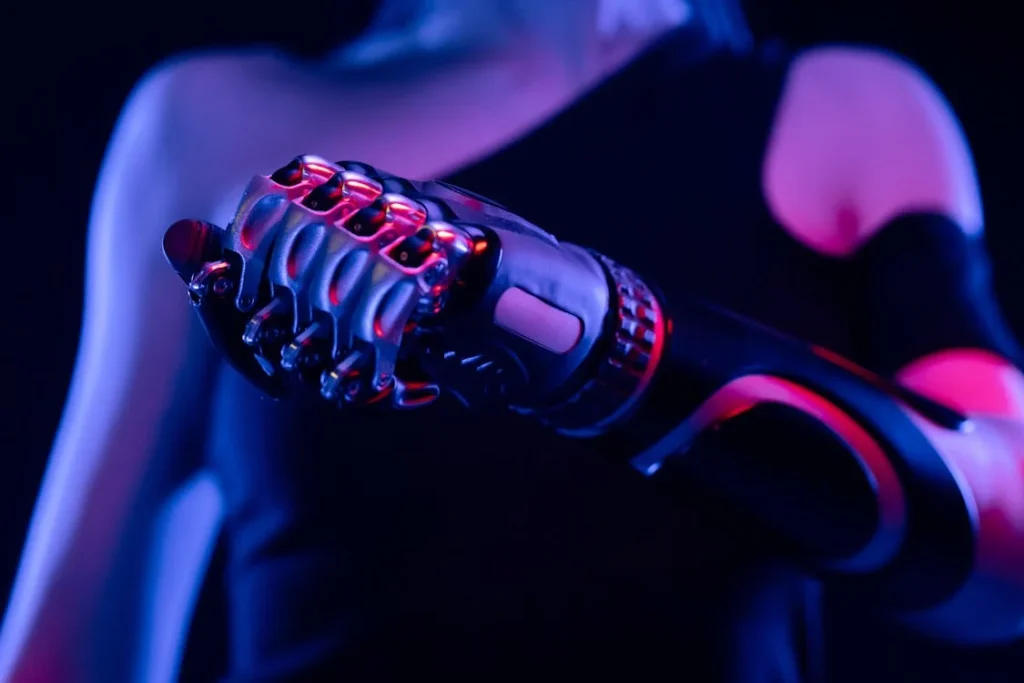
How Precision Grip Brings Back Control
What Is Precision Grip and Why It Matters
Precision grip is what lets you pick up a paper clip, turn a key, hold a pen, or use your phone. It’s not about how strong your hand is. It’s about how accurate and intentional your fingers are.
In the natural hand, this grip involves the tips of your thumb, index, and middle finger working together with tiny adjustments to pressure.
In everyday life, we use precision grip more than we realize. Typing, texting, writing, zipping a bag, even brushing your teeth—it’s all about controlled movements.
When someone loses a hand, this is one of the most frustrating things to lose, because it changes how you interact with small objects, tools, and people.
That’s why at Robobionics, restoring this grip is a top priority. Our bionic hands are equipped with finely tuned sensors that respond to the smallest muscle signals in your arm.
These signals are interpreted by the hand in real-time, allowing the fingers to move slowly, gently, and exactly as you want them to.
The result is that users begin to do things that once felt impossible. They can tie shoelaces, hold an ID card, flip a coin, or use a pen again. This kind of return to independence cannot be overstated. It doesn’t just bring back the ability to perform tasks—it brings back dignity.
How Bionic Technology Mimics Natural Precision
Inside the bionic hand are microprocessors that constantly calculate how to respond. They decide which fingers to move, how much to bend them, and how firmly to press. The more advanced the hand, the more realistic the response.
Unlike older prosthetics that simply open and close, bionic hands offer multiple grip modes. But what makes Robobionics different is that we don’t rely on buttons or complex menus to switch between them.
Instead, we use your own muscle signals as the switch. When your muscles move in a certain way, the hand interprets the pattern and changes grip mode.
This means you can go from holding a credit card to lifting a pan without pressing a single button. The change is automatic, quick, and seamless.
For precision grip to feel real, finger speed and feedback also matter. That’s why we’ve built haptic feedback systems into our hands—so you can feel a subtle vibration when the fingers touch something.
This lets your brain start to re-learn how to judge force, even without real sensation. It’s not the same as natural touch, but it helps you develop your own rhythm and trust.
With practice, users start to feel connected to the hand. It becomes part of their thinking, their daily rhythm, their muscle memory.
Precision in the Indian Context
What many global prosthetic makers forget is that different cultures use their hands in different ways.
In India, precision grip is used not just for writing and working, but also for things like eating with your fingers, performing religious rituals, handling spices while cooking, and pinching clothes while washing.
These aren’t luxury movements—they’re daily habits. So, when we design precision grip systems, we test for these local activities. We check if a user can pick up a small coin, light a diya, or pick rice off a plate. These actions matter, because they restore not just function, but familiarity.
For schoolchildren, being able to hold a pencil changes how they learn. For office workers, typing fluently builds confidence. For elders, being able to hold prayer beads or open medicine strips means safety and peace of mind.
That’s the power of precision. It’s not about being flashy. It’s about being real.
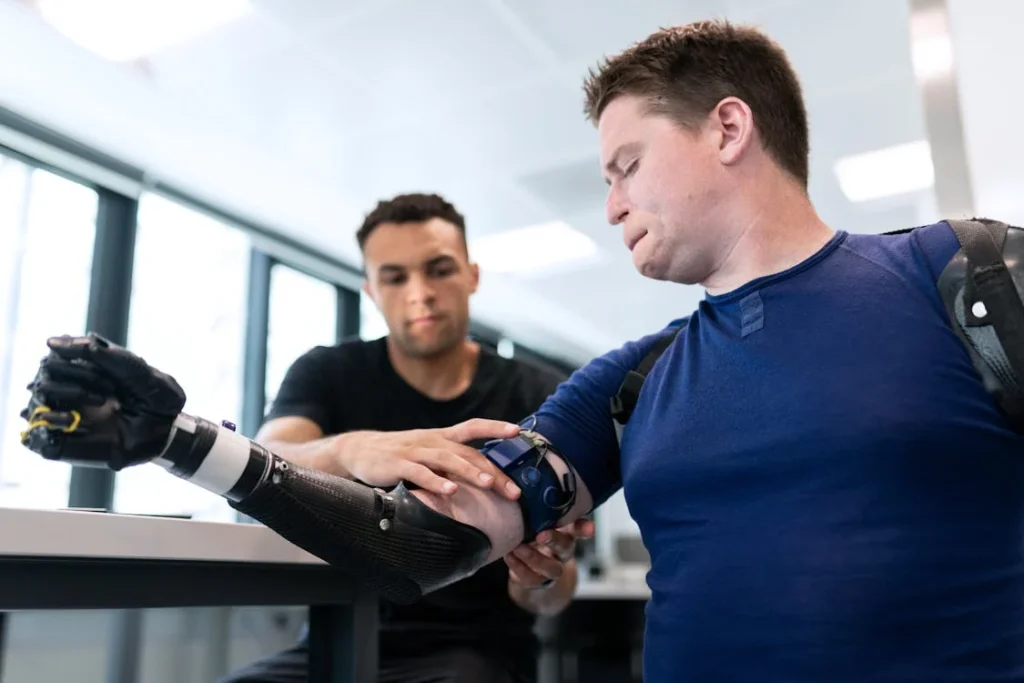
The Strength of Power Grip in a Smart Package
Why Power Grip Is About More Than Muscle
Power grip is what lets you carry, lift, push, or hold firmly. It’s the kind of grip you use when you’re holding a water bottle, carrying groceries, or gripping a bicycle handle.
In your natural hand, this involves wrapping your fingers and thumb around an object and using your whole palm to apply pressure.
In bionic hands, recreating this kind of grip isn’t just about making the hand strong. It’s about making it smart. Because power without control can be dangerous. A grip that’s too tight might crush an object—or hurt the user. A grip that’s too loose won’t hold properly.
Robobionics bionic hands use smart actuators and grip sensors to regulate force. When the hand begins to close, it doesn’t just clamp. It adjusts based on resistance.
If you’re holding something firm, like a suitcase, the hand tightens enough to support the weight. If you’re holding something soft, like a piece of fruit, the pressure drops instantly.
This dynamic adjustment happens every time. You don’t have to tell the hand how hard to grip—it learns from what it’s holding.
How We Build Safe Strength Into Our Designs
One of the most common worries among users is: “What if I drop this?” or “What if I squeeze too hard and break it?” That’s why our power grip system has built-in safety limits and override features.
The hand will never apply more pressure than needed. And if it detects strain on your residual limb, it adjusts automatically.
We also design the grip to support everyday Indian tasks. That means being able to hold stainless steel utensils, carry shopping bags, grip cycle or scooter handles, push doors, or even balance a bucket.
These aren’t simple tasks—they involve a mix of grip force, wrist angle, and reaction speed.
Our bionic hands are tested for weight-bearing support. That means the fingers don’t bend or warp under pressure.
The internal motors are sealed for dust and water protection, and the palm shell is built from lightweight but durable composite materials. So you get strength without bulk.
And power grip doesn’t just help with objects—it helps with posture. When your hand is strong enough to carry and hold, you walk more evenly. Your body doesn’t shift to compensate. That means less back pain, less shoulder strain, and better movement overall.
Returning to Active Life With Confidence
Power grip restores something deeply emotional: the ability to carry your own weight. Whether it’s holding your own luggage at the bus stop, helping your child off the floor, or pushing open a heavy gate, it reminds you that you are still strong. That your body is still capable.
We’ve seen users return to sports, to farming, to factory work—jobs that demand physical output. And the common phrase they share is this: “I feel like myself again.”
That’s what power grip really offers. Not just the strength to hold things—but the strength to hold onto your life.
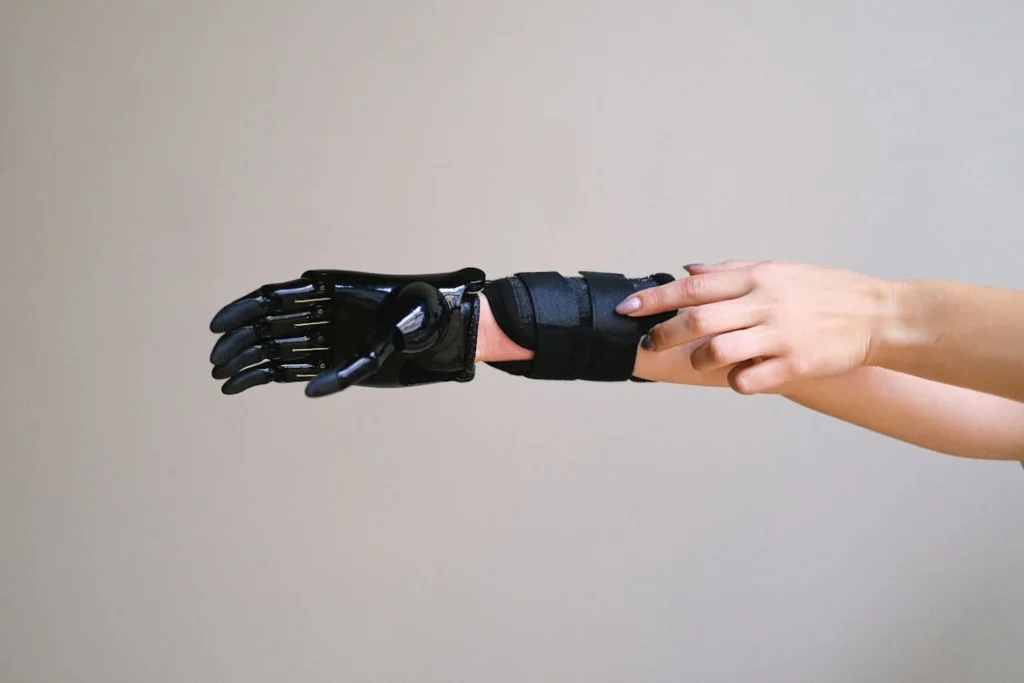
When Power Meets Precision: The True Genius of Modern Bionic Hands
Intelligent Switching Without Thinking Twice
The real brilliance of today’s bionic hands isn’t in the number of grip modes they offer. It’s in how naturally and seamlessly they shift between those modes without burdening the user. Think about how your natural hand works.
You don’t pause to “choose” whether you’re going to use a power grip or a precision grip. You just do it. Your hand responds automatically based on what you’re holding.
Bionic hands from Robobionics aim to do the same thing. We’ve designed an intuitive control system that reads your muscle signals, recognizes patterns in your movement, and adjusts the grip accordingly.
You don’t need to manually select “grip mode 1” or “grip mode 2.” The hand understands context based on force, speed, and signal clarity.
For example, if you move your hand slowly and deliberately, the hand switches to a precision grip. If you move your muscle quickly or apply more force, the system activates a power grip.
Over time, users become so used to this switching that they forget it’s happening. That’s the goal: invisible intelligence.
We also allow for manual override when needed, using simple gestures or smartphone apps, especially in situations where the user wants to lock into a particular grip for extended tasks.
How The Fusion of Grips Reflects Real Life Needs
Most real-life actions require both grip types, often one right after the other. Let’s take the simple act of cooking. You use a power grip to lift a heavy pan.
Then you immediately need a precision grip to turn on the gas knob. Or when working on a laptop, you use a power grip to move the device, but a precision grip to type or use a mouse.
In India, think about using public transport. You use a power grip to hold onto a handrail during a bus ride. Then you use a precision grip to pull out a metro card or open a zipper. These actions aren’t separate in your brain. They flow together. So your hand needs to respond in kind.
That’s why our hybrid grip architecture is built with continuous motion in mind. There’s no “start-stop” between grip styles. The hand transitions based on intent—fluid, fast, and natural.
This changes the entire experience of using a prosthetic. What used to feel robotic now feels human. What used to be effortful now feels easy.
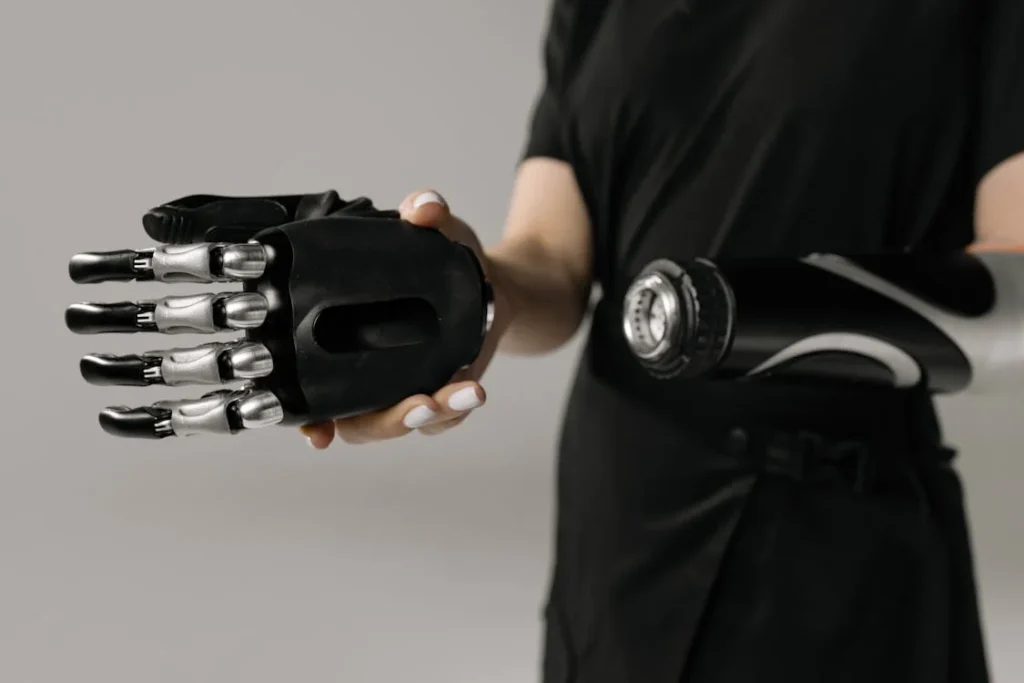
Real Stories: Living With Both Strength and Finesse
How Users Are Reclaiming Life, One Motion at a Time
Behind every grip pattern we design, there’s a story. A real person. A real life. A real reason why getting the motion right matters. And it’s these stories that fuel everything we do at Robobionics.
One of our users, Shweta, a graphic designer from Nagpur, lost her dominant hand in an accident. Her work required both creativity and precision.
Holding brushes, using tablets, even writing ideas on paper—everything depended on finger control. Her first attempt with a basic prosthetic failed. It was strong but stiff. It could hold a coffee mug, but not a pencil.
When she switched to our bionic hand with dynamic precision and power grip, her world changed. Within a few weeks, she was back to sketching. She learned to control stroke pressure by timing her muscle contractions.
And with the help of our sensory feedback system, she could even adjust pressure while working with delicate surfaces. Today, she not only runs her own design firm—she inspires other amputees to return to their professions with confidence.
Then there’s Ravi, a 42-year-old father of two from Jharkhand. He works in logistics. His job requires lifting cartons, loading sacks, driving vehicles, and handling documents. A traditional prosthetic offered him strength but no flexibility.
With our grippy hand that merged power and precision, he could do everything—carry boxes one minute, sign paperwork the next. His co-workers no longer needed to assist. He stood on his own again, literally and professionally.
Rediscovering Trust in the Body
One of the most overlooked parts of bionic hand adoption is emotional trust. It takes time to believe in your body again after limb loss. Many users describe an invisible hesitation. They ask themselves, “Can I do this?” “Will the hand respond?” “Will I drop this?”
When the grip responds consistently—whether strong or subtle—trust starts to build. And when trust is restored, everything changes. People begin to move faster. Their body language shifts. Their speech becomes more confident. They stop hiding their hand. They start showing it.
That’s the power of blending strength and precision. You’re not just giving someone tools. You’re giving them their rhythm back.
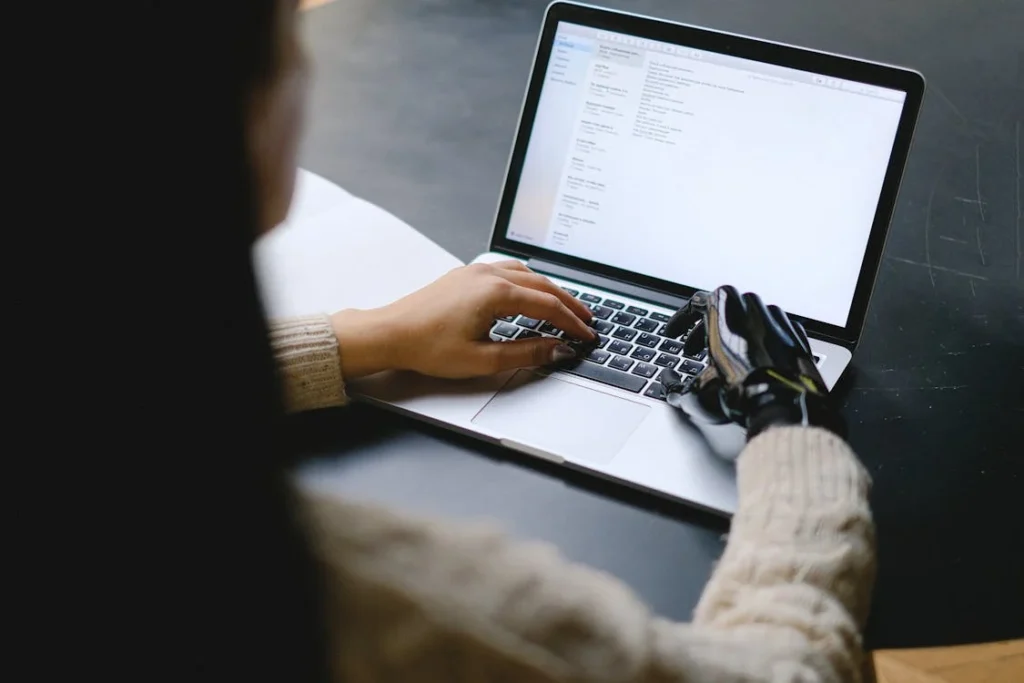
Beyond the Hand: Dexterity and Identity in Indian Society
Why Grip Shapes More Than Just Movement
In India, the hands are sacred. We eat with them. We greet each other with them. We worship with them. We express emotion, affection, and authority through touch. A hand isn’t just an appendage—it’s a cultural symbol.
So, when someone loses a hand, the impact goes far beyond physical ability. There’s often a sense of being left out—not just from tasks, but from rituals and roles. A mother unable to feed her child.
A student unable to fold hands in prayer. A bride hesitant to greet her in-laws. These are deep, personal moments where hands matter—not for what they hold, but for what they mean.
Our bionic hands are designed to restore that meaning. We don’t just test for strength or speed. We test for harmony. Can the hand hold incense sticks during Diwali? Can it perform the gentle circle of Aarti? Can it support the act of serving food to guests?
These aren’t “optional features.” They’re essential to the user’s identity. That’s why grip variety matters. Because precision and power don’t just restore function—they restore place. They return the user to their community, their family, their rituals.
And perhaps most importantly, they remove the label of “disabled” and replace it with “independent.”
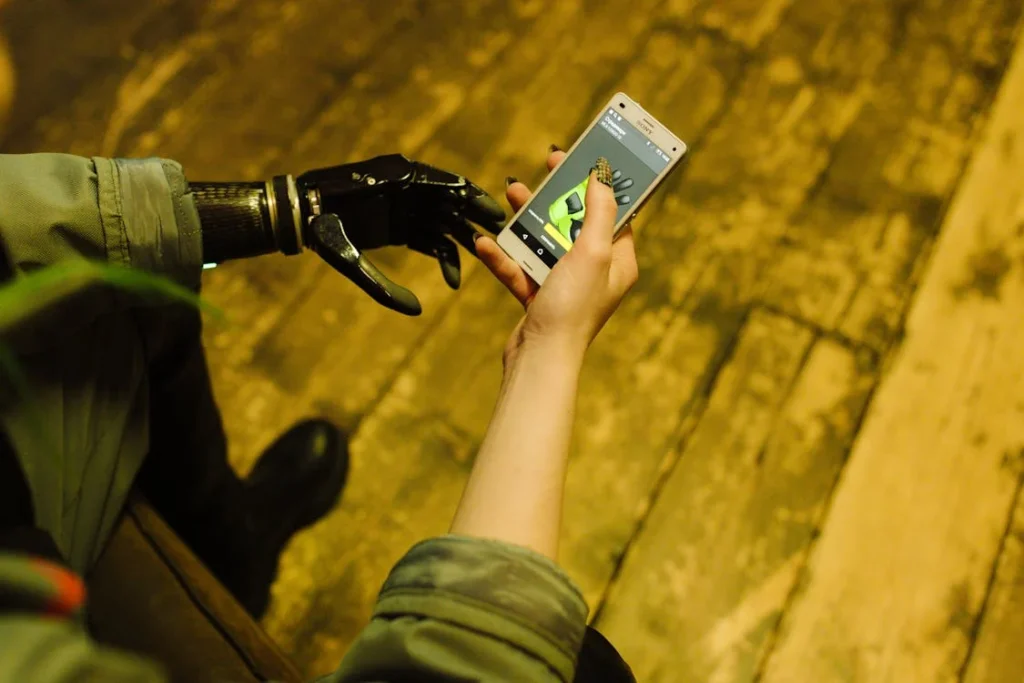
Training Hands, Retraining Minds: Building Muscle Memory and Confidence
Adapting the Brain to Adapt the Hand
Bionic hands are only half of the equation. The other half lies in the human brain. Even the most advanced device is only as good as the user’s ability to communicate with it—and for amputees, that communication starts with intention.
When someone begins using a Robobionics bionic hand, they don’t just put it on and go. They learn how to move it—how to fire the right muscles, how to time their contractions, how to guide their motion. It’s a journey of practice, feedback, and adjustment. But the results are worth every step.
What’s happening inside is even more powerful than what’s happening outside. The brain is building new maps. Areas once linked to a lost limb are reactivated and repurposed.
With every squeeze, flick, and release, the brain is rewiring itself—learning again how to use the hand that was lost, now reborn in a new form.
This is neuroplasticity in action. The more users engage with their hand, the faster and more naturally their movements become. Precision improves. Power becomes smoother. Grip transitions happen instinctively.
It’s not magic. It’s muscle memory. Rebuilt from the ground up.
Why Consistent Practice Builds Emotional Strength
Every day, we hear from users who describe their first few weeks of training as difficult—but also transformative. They talk about dropped spoons, missed touches, or awkward movements at first.
But then, something shifts. The hand starts responding more quickly. The mind begins predicting the hand’s response. Suddenly, tying a shoelace or buttoning a shirt becomes possible. Then easy. Then forgettable.
And that’s the true sign of progress: when the user stops thinking about the hand and just uses it.
At Robobionics, we walk with users through this phase. Our training is not just technical—it’s personal. We offer one-on-one coaching, video-based learning for rural areas, and culturally relevant task training.
We help users learn how to perform daily activities that reflect their actual life—whether that’s typing on a laptop, driving a scooter, cooking for the family, or lighting a diya.
And we remind them: it’s okay to take time. It’s okay to make mistakes. Because every movement, even a failed one, is a step closer to mastery.
This isn’t just about dexterity. It’s about identity. And every new skill learned through grip is a reminder that their story didn’t stop—it just changed direction.
Conclusion
The difference between a hand that simply holds and one that understands how to hold lies in intention, design, and trust. Today’s bionic hands, like the ones we build at Robobionics, are more than mechanical tools. They are living, adapting extensions of the human will. They think. They learn. They feel. And most importantly, they give users back their power.
But grip—whether it’s precise or powerful—is not just about what you can carry. It’s about what you can reclaim.
It’s about dignity, confidence, participation, and independence. It’s about sitting at a dining table and serving yourself. It’s about lifting your child, shaking a client’s hand, signing your name, and praying in the way you always have. It’s about not needing to be helped, unless you choose it.
And that’s why we believe the true measure of a bionic hand isn’t in how it looks or even how fast it moves—but in how deeply it lets a person live the life they choose.
So, when someone asks, “What does today’s bionic hand offer?”, the answer is simple:
It offers precision, for the delicate things.
It offers power, for the heavy things.
And it offers something greater than both—freedom.
At Robobionics, we’re proud to be part of that journey. One hand at a time. One grip at a time.



